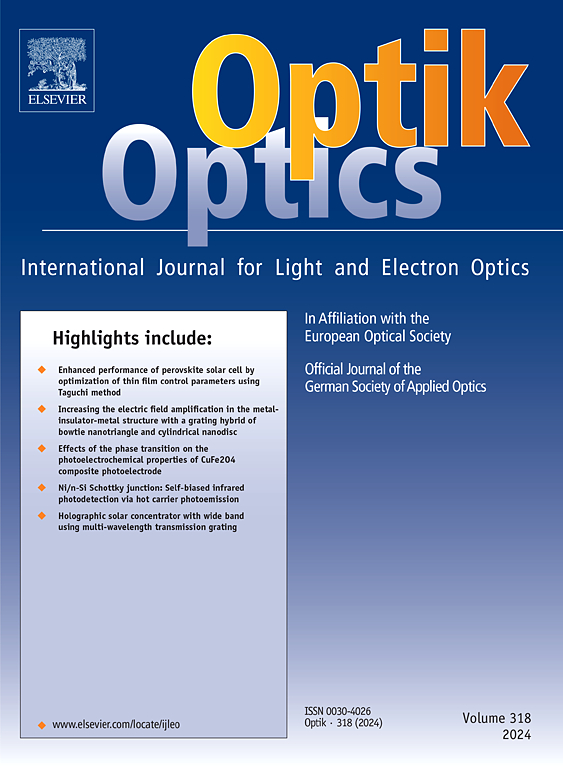Enhanced performance of perovskite solar cell by optimization of thin film control parameters using Taguchi method
IF 3.1
3区 物理与天体物理
Q2 Engineering
引用次数: 0
Abstract
The objective of the study is to examine the influence of various thin film control parameters on the synthesis of carbon-based passivated perovskite solar cells. Passivation additives, namely MOF UiO-66-NH2 (20 mg/ml) and inorganic additive KPF6 (1 mg/ml), were applied to treat the perovskite solar cells simultaneously. A PSC device of a standard configuration FTO/TiO2/Perovskite layer/Additives/HTL/Carbon electrode is utilized for experimentation. The performance evaluation of the system was carried out using Taguchi method. The critical control parameters considered in the study are: type of perovskite; annealing temperature of perovskite layer; the number of perovskite coating layers; and the type of hole transport layer (HTL). Each parameter is allocated three levels. An orthogonal array was designed using the Taguchi technique to optimize the quality control parameters. The signal-to-noise (S/N) ratio and analysis of variance (ANOVA) were then utilized to determine the ideal combination of parameters. The analysis identified the significant contribution of each parameter to the efficiency of perovskite cells. Among these parameters, the type of perovskite (used in the synthesis process) was found to impact the fabrication and performance of the cells significantly. Furthermore, it was observed that the type of hole transport layer (HTL) employed in the device significantly influences its performance. The best combination for our experiment is found to have FA0.55MA0.25Cs0.20PbI3 as the perovskite-type, an annealing temperature of 120˚C, a double layer of perovskite coating and Spiro-OMeTAD as the HTL. The solar cell is developed for each experiment as well as the validation test.
利用田口方法优化薄膜控制参数,提高过氧化物太阳能电池的性能
本研究旨在探讨各种薄膜控制参数对合成碳基钝化型包晶石太阳能电池的影响。钝化添加剂,即 MOF UiO-66-NH2(20 毫克/毫升)和无机添加剂 KPF6(1 毫克/毫升),被同时用于处理包晶体太阳能电池。实验采用了标准配置 FTO/TiO2/Perovskite 层/添加剂/HTL/碳电极的 PSC 设备。系统的性能评估采用田口方法进行。研究中考虑的关键控制参数包括:磷灰石的类型;磷灰石层的退火温度;磷灰石涂层的层数;空穴传输层(HTL)的类型。每个参数分为三个等级。采用田口技术设计了一个正交阵列来优化质量控制参数。然后利用信噪比(S/N)和方差分析(ANOVA)确定参数的理想组合。分析确定了每个参数对包晶石电池效率的重要贡献。在这些参数中,发现(合成过程中使用的)包晶石类型对电池的制造和性能有显著影响。此外,我们还观察到,器件中采用的空穴传输层(HTL)类型对其性能也有很大影响。在我们的实验中,发现最佳组合是以 FA0.55MA0.25Cs0.20PbI3 作为包晶类型,退火温度为 120˚C,双层包晶涂层和斯派罗-OMeTAD 作为 HTL。为每个实验和验证测试开发了太阳能电池。
本文章由计算机程序翻译,如有差异,请以英文原文为准。
求助全文
约1分钟内获得全文
求助全文
来源期刊

Optik
物理-光学
CiteScore
6.90
自引率
12.90%
发文量
1471
审稿时长
46 days
期刊介绍:
Optik publishes articles on all subjects related to light and electron optics and offers a survey on the state of research and technical development within the following fields:
Optics:
-Optics design, geometrical and beam optics, wave optics-
Optical and micro-optical components, diffractive optics, devices and systems-
Photoelectric and optoelectronic devices-
Optical properties of materials, nonlinear optics, wave propagation and transmission in homogeneous and inhomogeneous materials-
Information optics, image formation and processing, holographic techniques, microscopes and spectrometer techniques, and image analysis-
Optical testing and measuring techniques-
Optical communication and computing-
Physiological optics-
As well as other related topics.
 求助内容:
求助内容: 应助结果提醒方式:
应助结果提醒方式:


